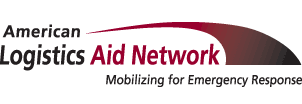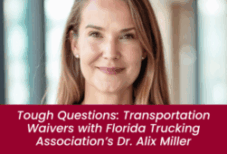Raise your hand if you totally understand the ins and outs of transportation waivers.
Still sitting on your hands? You’re not alone. In fact, sometimes waivers can be about as easy to navigate as Atlanta’s, LA’s and Houston’s rush hour traffic combined, which is why we decided to give them the VIP “Tough Questions” treatment they deserve – and asked the Florida Trucking Association’s Alix Miller (whose hurricane-prone home state is especially familiar with them) to help steer our discussion in the right direction.
Each time there’s a disaster, it seems to be followed by a bumper crop of transportation waivers. Walk us through why these waivers get issued – and who’s in charge of issuing them.
There are a lot of rules that govern truck operations, and rightfully so, because they play a huge role in keeping drivers and other people on the road safe – and protecting critical infrastructure like roadways and bridges. However there are times when some of these rules need to be temporarily relaxed for an equally important purpose: helping disaster survivors.
That’s why waivers exist.
Various government organizations have the authority to issue these time-saving disaster relief tools, including federal groups like the Federal Motor Carrier Safety Administration (FMCSA) and state entities like the Florida Department of Highway Safety and Motor Vehicles; hence you’ll see some waivers that apply to an entire region or even the whole country and others that are limited to specific states, counties or cities.
What kinds of trucking rules do waivers relax or temporarily suspend?
It runs the gamut, because each state determines its own waivers, and they can vary significantly. But some of the most common involve lifting Hours of Service rules, allowing trucks to carry heavier loads, temporarily eliminating tolls, or letting trucks bypass weigh stations. The intention of course is to increase the transportation capacity that’s available to serve affected areas while also reducing potential bottlenecks that might slow relief shipments down.
How long do waivers last?
Federal waivers are usually limited to 30 days, while state and local waivers can last up to 14 days. But waivers are also renewable, so it’s not uncommon to see them last for considerably longer than that if they’re needed. Even so, it’s important to remember that none of them are permanent.
What kind of loads qualify for waivers?
As a rule, waivers only apply to emergency loads that support relief operations or trucks that are performing critical relief activities like cleaning up debris that’s on roads. But that doesn’t necessarily mean they’re only for loads that have been commissioned by nonprofits or government organizations. Businesses can also use waivers provided they can demonstrate that the items they’re carrying are legitimately required for relief efforts.
So a company’s shipments of things like fuel, water, medicines and tarps might be covered by waivers if they’re headed to a disaster zone but its loads of cosmetics, designer jeans and Christian Louboutin shoes wouldn’t be. . . .
You’ve got the idea, although some might joke that fashion emergencies are equally legit!
Other products that commonly qualify for waivers include building supplies, temporary housing, generators, items that are being used for disaster clean-up, and toilet paper.
Assuming a company *is* carrying relief supplies, when should it expect to expect a specific disaster’s waivers to begin appearing? And where can it find information about them?
Waivers can be issued immediately before, during and after disasters. In Florida, for example, many waivers go into effect anywhere from four to six days ahead of a hurricane or tropical storm, while others go into effect immediately after disasters like wildfires occur.
Some waivers can also be issued long after a disaster has occurred in order to support the movement of relief materials that are needed later in the game.
As for where companies can find out about waivers, there are a number of options including:
- the Emergency Declarations, Waivers, Exemptions and Permits section of the FMCSA website (for national or regional waivers)
- state trucking associations’ websites (for state waivers)
- state trucking associations’ social media channels (many will announce new waivers on platforms like X)
- ALAN’s Disaster Micro-Site (for disaster-specific state, regional or national waivers)
- ALAN Situation reports (for disaster-specific state, regional or national waivers; to sign up to receive these reports, e-mail ALAN at www.alanaid.org/contact
Earlier in this discussion, you mentioned that waivers can differ significantly from state to state. How?
Just like Dorothy had to learn that she wasn’t in Kansas anymore, businesses always need to be mindful that each state comes with its own set of – and mindset about – waivers.
Among other things, some states may issue waivers for certain kinds of disasters more quickly than others. Other states may not be able to make their waivers as lenient about things like increasing load weights because some of their bridges have lower load-bearing limits.
States can also vary in terms of how many waivers they decide to issue for a particular disaster, where within their borders those waivers apply, or whether they feel like waivers are merited for a particular disaster at all.
(And by the way, the latter isn’t as heartless as it sounds. After all, it’s highly unlikely that hurricane relief supplies will need to travel from Washington State to South Carolina, and just as unlikely that winter storm relief supplies will need to make their way from Florida to Minnesota.)
We’ve bent your ear for quite a while. Any final words of wisdom before we “waive” goodbye to this discussion? (Sorry. We couldn’t resist.)
If your company anticipates traveling through or making disaster-related deliveries to specific states, it’s a good idea to familiarize yourself with the particulars of each of those states’ typical waivers – and the federal government’s — well before the next disaster hits so that you’ll be ready to hit the ground running and avoid any unfortunate surprises. This is especially true as we approach what is usually the busiest part of hurricane season.
Also, regardless of how much your company is or isn’t able to use waivers, we hope that you will still be a fan of them, just as we are. Ultimately they’re about using the power of trucking to save lives and rebuild communities as quickly and efficiently as possible. And that’s a purpose we can all get behind.

